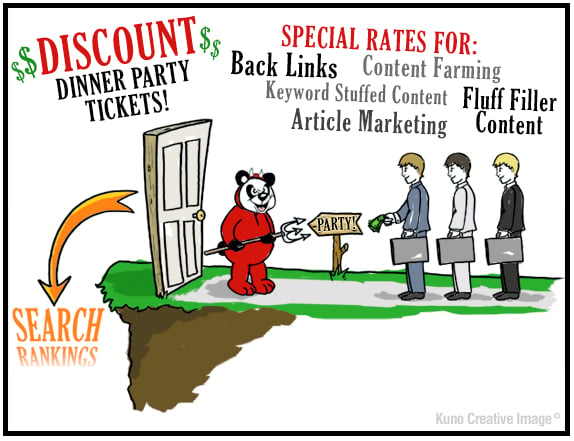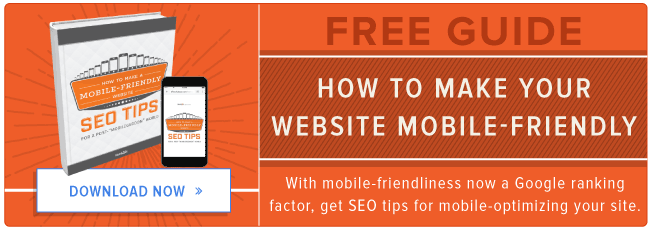 We all learned a lot after this year's Google Panda updates. Some site owners felt vindicated by finally seeing their efforts at legitimate SEO paying off. Others were punished severely in the SERPs for grey and black hat tactics. While some of the vanquished were marketing professionals deeply entrenched in the ins and outs of SEO, unfortunately, many of them were people who turned their site over to an agency for management, or people who just plain didn't know any better.
We all learned a lot after this year's Google Panda updates. Some site owners felt vindicated by finally seeing their efforts at legitimate SEO paying off. Others were punished severely in the SERPs for grey and black hat tactics. While some of the vanquished were marketing professionals deeply entrenched in the ins and outs of SEO, unfortunately, many of them were people who turned their site over to an agency for management, or people who just plain didn't know any better.
So what's the glass half full perspective on all of this? Well, Google Panda is kind of forcing site owners and managers to be, well, good marketers. With the help of SEOMoz's algorithm timeline and Kuno Creative's fantastic cartoons, let's look back at the year's Google Panda updates and see how we can leverage them to be better marketers.
January-February 2011: Google Punishes JC Penney and Overstock.com for Shady Link Practices
In the beginning of the year, JC Penney and Overstock saw dramatic falls from page one of the SERPs when Google punished them for getting links to product pages from irrelevant sites. The quality of an inbound link in Google's algorithm became based on relevancy and site authority.
How marketers can leverage it: If it's easier for you to find time in the day than dollars in your budget, you'll get tons of leverage out of this algorithm update. Instead of buying coveted inbound links, you can get them by maintaining a quality site, upping the frequency with which you generate interesting content, and creating a solid distribution network. Marketers willing to put the time into doing this consistently will see more qualified visitors and enjoy a wider social reach because of their affiliation with other relevant sites.
 February, 2011: Panda Cracks Down on Content Farms
February, 2011: Panda Cracks Down on Content Farms
Google didn't rest long, emerging with the first official Panda update in February that targeted sites with content that was spammy, low quality, and littered with ads. This update affected a whopping 12% of searches.
How marketers can leverage it: Old school marketers should have fun with this update. Marketing is about writing for people again, not at them. Instead of creating spammy, keyword dense content, you get to do market research, talk to users on social networks, and craft personas. Marketers and site owners can leverage this update by finding out what their audience wants to read, and addressing those issues in a helpful way. Power to the people!
March, 2011: Google Launches +1 and Incorporates Social Sharing Into the Algorithm
More changes continued to roll out, and in March, Google's algorithm started to consider social sharing more heavily than it did in the past. This obviously coincided with their development of the +1 button, Google's attempt to get back into the social world.
How marketers can leverage it: Marketers that have a great social media presence or are trying to make the case for one can use this algorithm update to justify social media for marketing. Marketers who are new to the social media game can also start on an even playing field with Google+ Business Pages, because they're brand spanking new! If you don't know where to start, the best way to make social media work for you is to start by distributing your content there. Then add social sharing buttons on your blog, in your emails, and on your site's homepage to start building a follower base of people with whom you can engage and turn into new prospects and evangelists.
 August, 2011: Google Displays Expanded Site Links
August, 2011: Google Displays Expanded Site Links
Used primarily for branded search, Google launched expanded site links to help users pinpoint what they're looking for on a site despite a vague search phrase. If a user enters HubSpot, for example, they then see the homepage followed by six links to pages on HubSpot.com that predict what the user might want to see.
How marketers can leverage it: You can leverage this update by nailing down your value proposition, and finding a way to convey it in just 30-35 characters of space. By making the benefits of each page crystal clear, you'll help searchers figure out what they were looking for when they typed in your name. Once they click on one of those links, be sure to turn those visitors into leads with a compelling offer. By optimizing the expanded site links and the pages they lead to, you'll get more visibility for and conversions on those important pages that you want people to visit.
October, 2011: Google Begins Encrypting Search Queries
For users logged in while performing a Google search, search referral data is no longer passed to the destination site that the user clicks. In other words, site owners can't tell what keywords someone searched to get to their website if the searcher was logged in to Google.
How marketers can leverage it (can they?): Not all of the Google's algorithm updates have helped marketers. As a result of this algorithm update, HubSpot has seen 13% of our overall search engine traffic come through without keyword information; that number averages to 11.36% across the HubSpot customer base, though some sites have been hit worse. Aside from advising marketers to be aware of why their organic search data has changed, we're still trying to figure out how to adjust to the SSL encryption. When we figure it out, you can be sure we'll let you know.
November, 2011: Google's Algorithm Now Rewards Freshness of Content, Impacting 35% of Search Queries
Most recently, Google's algorithm has been updated to reward fresh and timely content, impacting a whopping 35% of searches.
How marketers can leverage it: When a change occurs, people want to know a.) what it is, and b.) how it will affect them. Now, marketers are rewarded in the SERPs for staying on top of news and being the first to pontificate. Leverage the power of first response by establishing yourself as a thought leader in your industry. Not only will your site and brand reap the benefits, but your network will also.
One of the best parts of the Panda updates is that Google has essentially crowdsourced some important components of its algorithm; the best results require data based on the opinions of the masses. By recognizing the limitations of an algorithm to deduce something as subjective as quality, they've tapped into the human component of web surfing to do their jobs better, forcing marketers and site owners to remain accountable to visitors.
Did Google Panda affect your site? Did it change the way you approach SEO?
Image Credit: Kuno Creative


 February, 2011: Panda Cracks Down on Content Farms
February, 2011: Panda Cracks Down on Content Farms August, 2011: Google Displays Expanded Site Links
August, 2011: Google Displays Expanded Site Links
![The Top Search Engines Other Than Google [+ Some You Might Not Expect]](https://www.hubspot.com/hubfs/other%20search%20engines%20header%20image%20.jpg)







